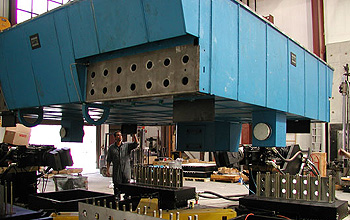Media Advisory 07-003
And the Bridge Came Tumbling Down
8.0 magnitude indoor quake to test massive bridge
February 7, 2007
This material is available primarily for archival purposes. Telephone numbers or other contact information may be out of date; please see current contact information at media contacts.
Researchers studying the effects of earthquakes will use an array of three enormous shake tables to rend a 110-foot-long test bridge. Part of the National Science Foundation (NSF) George E. Brown Jr. Network for Earthquake Engineering Simulation (NEES), the University of Nevada, Reno, facility will be the first in the world to test a four-span bridge of this scale. The ultimate forces will reach twice the strength of the 1994 Northridge earthquake.
| Who: | Project Director M. Saiid Saiidi, University of Nevada, Reno, and visitors from NEES affiliates across the country |
| What: | Test of bridge span under extreme earthquake forces. The heavily instrumented structure will be recording data to help engineers understand the impact of earthquake forces on bridges and other construction. |
| Where: | The University of Nevada, Reno, campus in the James E. Rogers and Louis Wiener Jr. Large-Scale Structures Laboratory. |
| When: | Thursday, Feb. 15 at 10 a.m. local time |
The bridge model can be viewed anytime at: http://tpm.ce.unr.edu/perl/portal.pl?section=local_video.
The actual tests on Feb. 15 may be seen at: http://nees.ce.unr.edu/telepresence/
More information on NEES is available at: http://www.nsf.gov/news/special_reports/nees/index.jsp
-NSF-
Media Contacts
Joshua A. Chamot, NSF, (703) 292-7730, email: jchamot@nsf.gov
Sue Putnam, University of Nevada, Reno, (775) 784-1169, email: sueputnam@unr.edu
Program Contacts
Joy M. Pauschke, NSF, (703) 292-7024, email: jpauschk@nsf.gov
Principal Investigators
M. Saiid Saiidi, University of Nevada, Reno, (775) 784-4839, email: saiidi@unr.edu
The U.S. National Science Foundation propels the nation forward by advancing fundamental research in all fields of science and engineering. NSF supports research and people by providing facilities, instruments and funding to support their ingenuity and sustain the U.S. as a global leader in research and innovation. With a fiscal year 2023 budget of $9.5 billion, NSF funds reach all 50 states through grants to nearly 2,000 colleges, universities and institutions. Each year, NSF receives more than 40,000 competitive proposals and makes about 11,000 new awards. Those awards include support for cooperative research with industry, Arctic and Antarctic research and operations, and U.S. participation in international scientific efforts.
Connect with us online
NSF website: nsf.gov
NSF News: nsf.gov/news
For News Media: nsf.gov/news/newsroom
Statistics: nsf.gov/statistics/
Awards database: nsf.gov/awardsearch/
Follow us on social
Twitter: twitter.com/NSF
Facebook: facebook.com/US.NSF
Instagram: instagram.com/nsfgov



